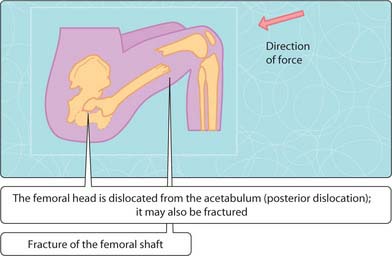49 Lower limb fractures
Fractures of the lower limb are common. Fractures of the neck of femur are extremely common and because of its importance and prevalence, it has a dedicated chapter (50).
Femoral shaft fracture
Femoral shaft fractures most commonly occur in young people as a result of high-energy impacts (e.g. road traffic accidents (RTA; Fig. 3.49.1)), but they may also occur in those with oesteoporosis. The risk of complications is high: shock (a femoral fracture results in blood loss of 1–2 litres, and the femoral artery may be damaged), fat embolus, thromboembolism and infection. Treatment is commonly surgical with an intramedullary nail, where screws can be passed through the bone and nail to prevent rotation (a locking nail). Traction, cast bracing and external fixation are also sometimes used.
Around the knee
Intra-articular joint involvement is common in knee trauma, and any disruption in the joint line must be accurately reduced to prevent post-traumatic osteoarthritis. The fractures around the knee can be divided into supracondylar, femoral condyle, patellar and tibial plateau fractures. The last range from simple to very complicated (Fig. 3.49.2), involving both the tibia and femur; there are often depressed, crushed and cleaved off segments, which must be accurately elevated and fixed into position to ensure a good joint line.
< div class='tao-gold-member'>
Stay updated, free articles. Join our Telegram channel

Full access? Get Clinical Tree











